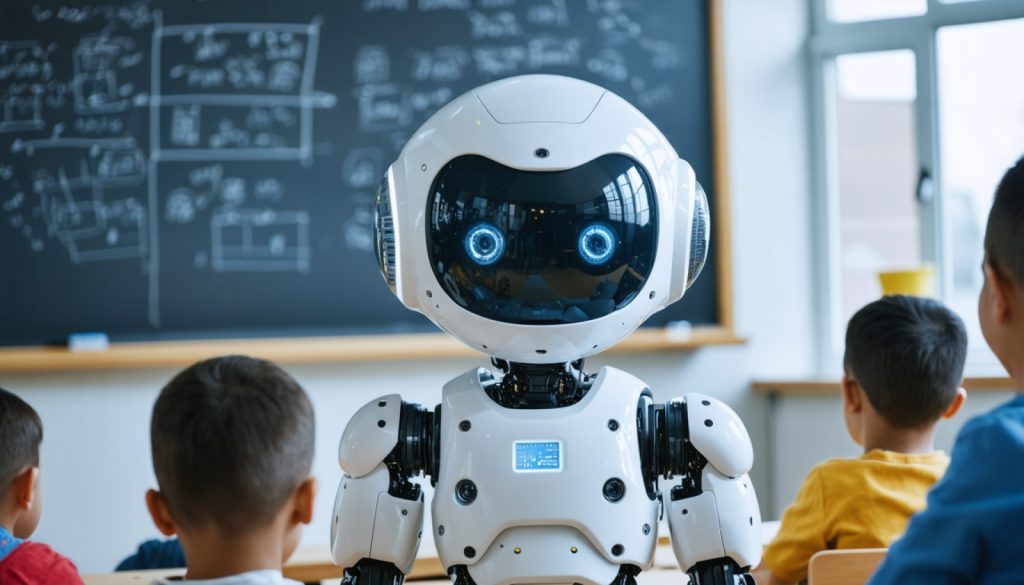
- The rise of artificial intelligence is transforming education, challenging traditional teaching methods while offering innovative opportunities.
- The AI Show @ ASU+GSV in San Diego will bring together over 10,000 global educators and tech leaders to discuss AI’s role in education.
- AI literacy is crucial for students, equipping them to navigate an AI-driven workforce and critically assess AI’s impact.
- Advanced AI tools provide personalized learning experiences and can simplify educators’ tasks, allowing for more effective teaching.
- Challenges such as data privacy and equitable access to AI resources must be addressed to ensure broader implementation.
- Ongoing teacher development and micro-credentials are essential for integrating AI into educational practices effectively.
- The potential of AI in education extends beyond technology to enhancing human understanding and fostering empathy and collaboration.
- A balanced integration of AI and human insight is essential to shape future educational landscapes.
The rhythms of education are being rewritten by the swift currents of artificial intelligence, as schools, teachers, and students across the globe navigate this transformative technology. The emergence of AI is reshaping the landscape of learning, prompting educators to tackle challenges and embrace innovations that are as electrifying as they are daunting.
Amidst this upheaval, the upcoming AI Show @ ASU+GSV, set to take place in San Diego this April, promises to serve as a crucible for discussion, innovation, and collaboration. Dubbed “the Davos of education” by Forbes, the summit will gather over 10,000 educators, tech leaders, and AI pioneers from more than 110 countries, underscoring its global significance. This year, the theme “Learning at the Speed of Light” aptly captures the breakneck pace of change and the exhilarating potential lying in AI’s embrace.
At the core of this educational evolution lies the concept of AI literacy—an essential skillset for today’s students who will soon find themselves in a workforce increasingly reliant on AI technologies. Institutions like the Linda Vista Innovation Center in San Diego are at the forefront, equipping students with the understanding needed to not only interact with AI but to critically assess its applications and implications.
For educators, embracing AI means redefining their teaching paradigms. Advanced AI tools, like adaptive assessment platforms and intelligent tutoring systems, offer unprecedented opportunities to tailor educational experiences to individual student needs, identifying gaps before they become chasms. These technologies not only aim to enhance learning but also to streamline educators’ workloads, freeing them to focus on delivering more targeted and impactful instruction.
Yet, as with any technological advancement, challenges to equitable AI integration abound. Schools must grapple with data privacy concerns and ensure robust protections as AI systems collect vast amounts of detailed information. A critical hurdle remains in bridging the access gap; ensuring all schools, irrespective of their resources, have the infrastructure necessary for AI’s effective implementation.
A proactive approach to teacher development is vital. Beyond cursory training workshops, educators need ongoing, peer-supported learning environments to fully exploit AI’s benefits. Micro-credentials present a promising path, offering bite-sized certifications that enhance teachers’ confidence and capabilities in utilizing AI, and recognizing this development in career advancement opportunities.
The ultimate promise of AI in education lies not just in its potential to revolutionize learning content but in its power to deepen students’ understanding and enrich the human experience. As the fields of knowledge expand, education must not only keep pace but also guide AI’s integration in ways that foreground empathy, critical thinking, and collaboration.
Educators and policymakers are tasked with crafting a harmonious balance between the machine and the human. The narrative of AI in education is still being written, and while its future remains a thrilling mystery, the foundations laid today will define the landscapes of tomorrow’s classrooms. In embracing AI, education can light the way for generations to come.
AI in Education: A New Dawn for Learning and Teaching
The AI-Driven Transformation of Education
As the realm of education witnesses a seismic shift powered by artificial intelligence (AI), schools, teachers, and students worldwide are engaging with innovative technologies that promise vast potential and formidable challenges. The upcoming AI Show @ ASU+GSV in San Diego, heralded as “the Davos of education,” is a focal point for global collaboration among educators and tech leaders, spotlighting the theme “Learning at the Speed of Light.”
AI literacy is becoming an indispensable skill for students poised to enter an AI-centric workforce, demanding education systems to adapt swiftly. Institutions like the Linda Vista Innovation Center in San Diego are pioneering this educational evolution by offering students the ability to interact with and evaluate AI technologies critically.
How AI is Reshaping Educational Paradigms
1. Personalized Learning:
– Advanced AI tools such as adaptive assessment platforms and intelligent tutoring systems are transforming the educational experiences of students by customizing learning paths based on individual needs.
2. Enhanced Teaching Efficiency:
– AI technologies offer educators tools to streamline workloads, allowing them to concentrate on providing enriched, impactful instruction.
3. Data Privacy and Access Equity:
– The integration of AI in schools raises significant data privacy concerns. Ensuring equitable access to AI-driven education remains a challenge, especially in under-resourced institutions.
Life Hacks for Teachers: Embracing AI
1. Teacher Development:
– Beyond basic training, teachers should engage in sustained, peer-supported learning to fully leverage AI’s educational benefits.
– Micro-credentials offer a practical approach for educators to gain recognition in AI competencies, enhancing career prospects.
2. Collaborative Learning Environments:
– Encourage educators to participate in collaborative learning environments that foster shared experiences and innovative teaching strategies.
Real-World Use Cases
1. AI in Curriculum Design:
– AI algorithms can aid in the design of curriculums that cater to diverse learning styles and capabilities, improving engagement and retention.
2. Monitoring Student Progress:
– AI tools can provide real-time analysis of students’ performance, helping teachers address learning gaps promptly.
Trends and Predictions
– Growth in AI EdTech Investment: Investment in AI for education technology (EdTech) is expected to grow exponentially as schools seek to adopt advanced learning technologies (source: Market Intelligence Reports).
– AI as a Collaborative Tool: Future classrooms will see AI not as a replacement but as a collaborative tool that complements traditional teaching methods.
Security & Sustainability Concerns
– It is paramount to establish robust data security protocols to protect student information as AI systems accumulate vast data sets.
– Sustainable AI education systems should focus on inclusivity and accessibility to ensure no student is left behind due to technological disparities.
Actionable Recommendations for Educators
– Seek continuous professional development opportunities related to AI in education.
– Foster AI literacy among students by integrating AI-related topics into various subjects.
– Advocate for equitable AI resources across educational institutions to bridge the digital divide.
For more insights into educational advancements, check out organizations like the EdTech Magazine and the ASU+GSV Summit.
In the journey towards integrating AI in education, educators must craft a harmonious balance between human empathy and machine efficiency. The narrative of AI in education is still unfolding, and the steps taken today will define the classrooms of tomorrow. Embracing AI wisely can illuminate the path for future generations, fostering a learning environment where technology enhances, rather than detracts from, the human experience.



